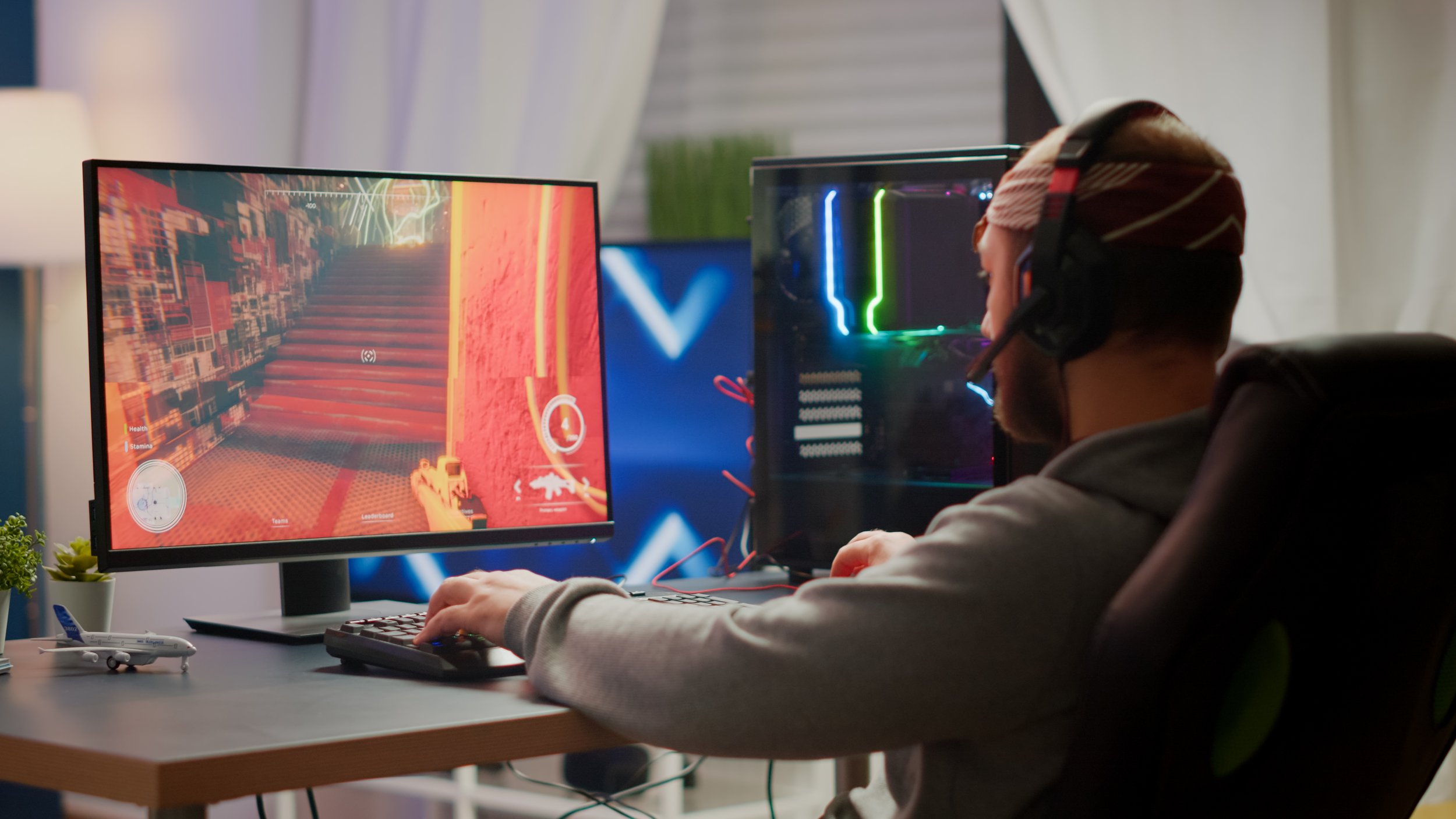1st Person vs 3rd Person Games: The Ultimate Gamer’s Guide
One of the most fundamental aspects of any story — whether it's told through writing, film, or a video game — is perspective.
Point of view shapes how the audience experiences a story, and it says a lot about the author’s intent, too. Even if you’re brand new to video games, you’re probably familiar with first- and third-person points of view from literature classes you’ve taken in the past.
Today, we're talking about how those points of view affect video games. We'll break down the technical differences between a first-person and third-person game, the merits of each, and the ways they can impact a game.
Whether you’re a new gamer looking to choose your next game, an experienced gamer seeking to deepen your knowledge, or a game designer brainstorming which perspective you should choose for your next game, this article has something for you.
Let’s get started!
What’s the Difference Between 1st Person and 3rd Person?
Before we talk about the implications of each perspective when it comes to gaming, let’s establish some clear context and definitions.
Since these points of view originate from oral and literary storytelling traditions, it’s best to start there.
You can identify a first-person perspective in such a story when the narrator uses first-person pronouns, such as “I” or “My.” Likewise, a third-person perspective uses third-person pronouns, such as “they”, “she”, or “he.”
These identifiers are easily applied to a language-based story, but when we discuss perspective in video games, we’re usually talking about visual perspective. In other words, we’re discussing the camera’s point of view.
At this point, we should note that “1st person” and “3rd person” are labels mostly used in the context of 3D, character-driven games.
2D games or games that aren’t character-focused (such as certain simulation or strategy games like Total War or Cities: Skylines) simply don’t follow the same conventions and use their own unique perspective systems.
What Is 1st Person Perspective?
The 1st person video game perspective is one in which the camera shows you what your character sees.
In many ways, it’s the more intimate perspective, bringing you closest to the action. To move your viewpoint, you’ll have to move your character. You won’t be able to see anything that’s not directly in front of you or in your most immediate peripheral vision.
More often than not, a first-person game will include a view of your character’s arms and anything they’re carrying in their hands into your viewpoint, but that’s not always the case.
In many games, your screen might begin to change depending on the state of your character’s vision. For instance, if your character is slowly fading to unconsciousness, the borders of your screen may become darker and darker, narrowing your field of view. If your character is hurt, a red vignette may surround your screen.
What Is the 3rd Person Perspective?
A 3rd person video game perspective is one in which the camera looks onto your camera from an outside point of view.
In most cases, especially with modern video games, this is implemented as an over-the-shoulder or behind-the-back perspective. However, many third-person games allow you to rotate the camera so you can see from different angles, even staring directly at the front of your character as you play to see what’s behind you.
Unlike a first-person perspective, third-person allows you to see your character’s body. How far back this perspective “zooms” can vary. Sometimes you only see their shoulders and the back of their head, while other times you can see them from head to toe and a few feet around them in any direction.
Another factor that distinguishes first-person games from third-person is how you control the camera. In a third-person game, there are many different systems for camera control.
Most third-person games allow free control of the camera, letting you rotate it in any direction and even move it away from your character, in some rare cases.
Though less common, a tracking third-person perspective is another option, maintaining the same relative rotation to whichever direction your character is facing.
In some games, a third-person camera might even be fixed, holding a single position and rotation depending on your character’s “zone.” You can find this technique in older games such as the first Resident Evil games and occasionally in other games like God of War, but it's rarely used in modern games.
How Do 1st and 3rd Person POV Affect Different Types of Games?
When it comes time for a developer to choose between the first- and third-person perspectives, there are a lot of factors to consider. The way each perspective affects a game is significant and can be more appropriate for different game styles.
Perspective in Shooter Games
The first-person perspective is extremely common in shooter games. In fact, first-person shooters (or FPS) are the most popular type of game in the world.
The primary reason for the popularity of first-person perspective when it comes to shooters is likely due to practical reasons: it’s often seen as the best way to quickly and accurately aim. It minimizes the distance between you and your crosshairs and gives you the closest view of what you need to shoot.
This is especially important in highly competitive online shooters where coordination and fast reaction times are the focus.
Still, a third-person perspective has its own merits in shooter games. It's easier to stay aware of your surroundings when you can see around your character rather than only through their eyes, allowing you to better identify threats.
If a third-person game allows camera rotation, you can even use your camera to see around corners and into places where your character themselves can’t actually see.
This could be seen as a pro or con, depending on whether gaining an advantage or maintaining realism is more important to you. For example, a game like Rainbow Six: Siege would be greatly hindered by such a mechanism due to the emphasis on tactical awareness through a limited perspective.
Perspective in Other Games
Third-person perspective tends to dominate every genre outside of shooters.
There are exceptions, such as first-person puzzle games like Portal or first-person RPGs such as Skyrim. Even in the case of Skyrim and many other games with first-person cameras, a third-person option is often included.
So what are the merits of the third-person that make it so much more popular outside of shooter games?
For one, third-person perspective has the potential to increase immersion and a game’s storytelling ability.
When you can see more of your character — including their outfit and movement animations — you get to know more about them. For some, this can make it easier to immerse yourself into their role.
For designers, this gives many more tools to work with. Games such as Zelda: Breath of the Wild are famous for the way they immerse players in the character story through visual cues using a third-person perspective.
First-person also has its own merits in terms of immersion for certain types of games.
For example, seeing through the character’s eyes can aid the imagination in terms of putting yourself in that situation. This especially shines in high-tension scenarios, such as stealth or horror games, as the limited and intimate perspective can increase feelings of fear and stress.
On the other hand, the first-person perspective limits other tools a designer might have at their disposal. In a first-person roleplaying game, for example, the character can only really be developed through the way other characters interact with them.
Which Is Better: First or Third Person?
Ultimately, neither first-person nor third-person is truly superior to the other. It always depends on the type of game and what the developer wants your experience to be.
There are benefits and disadvantages to each perspective. First-person games can provide greater immersion in some cases, but some games thrive in third-person perspective.
Today, we see many games including an option for both, such as Destiny.
What matters most is not the mode of storytelling, but the quality of the story being told.
WTFast GPN
Whether you play first-person or third-person games, if online gameplay is part of the deal, you’ll never get the best experience if lag sticks around.
For your fullest gaming experience yet, use our WTFast GPN. It’s a quick and simple solution to cut lag for good. Like a VPN, it reroutes your connection, but unlike a VPN, it puts the speed and stability of online gameplay as the top priority.
Worried about security issues? Our GPN service is safe to use but never changes your connection in a way that would cause flags from online game servers. You can game on without any worries of being flagged as a bot or hacker, nor any worries of lag or connection drops.
Try the new secret weapon against lag today to enjoy your first-person games, third-person games, or any other game to their full potential.
Sources:


